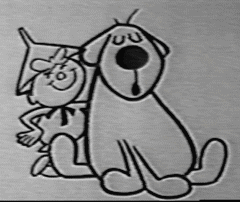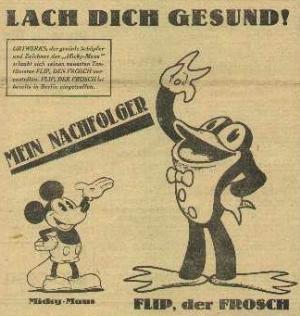Starting the Discussion
The Competition:
Van Beuren, Terrytoons, and Ub Iwerks
Maltin,
pp. 125-147; 189-208
Today we'll be looking
briefly at three studios (Terrytoons, Van Beuren, and Ub Iwerks) that found
themselves in competition with the Disney juggernaut in 1930s Hollywood. Your
focus in each case should be the strategies used by each studio to be competitive
while still making enough money to keep the business going, as well as the kind
of product in which each studio specialized.
 Terrytoons
Terrytoons
- Paul Terry's Terrytoons was the
only one of the three to not only survive, but also to go on making cartoon
shorts long after Disney had virtually abandoned the form. The self-proclaimed
"Woolworth's" of animators, Terry still managed to outlast them
all. How did he do this?
- Explain the advantages and drawbacks
of modelling an animation studio on the Ford assembly line.
- Why did people like the Aesop's
Fables series? How did this series become the model for the rest of the
Terrytoons productions?
- How did Terry adapt to the coming
of sound? How about color? Why?
- When unions became more powerful
in the 1940s, how did Terry respond? How did his response to unionizing differ
from Disney's?
- Why did Terrytoons never produce
a feature-length cartoon?
- What was the most successful character
series produced by Paul Terry? How was Terry able to extend the life of that
character when he had been unable to do so with earlier ones?
- "Perhaps the most remarkable
thing about Terrytoons of the 1950s was that they hardly looked different
than Terrytoons of the 1930s," Maltin points out on p. 146. Why was that?
- When Paul Terry sold his studio,
who benefitted?
- Gene Deitch, who became the new
head of the studio under CBS ownership, is a name we'll be hearing again when
we get to the UPA cartoons for television in the 1950s. How did the studio
product change under his leadership? Why might you see this change as ironic?
- What made the Tom Terrific series
so popular?
- Ralph Bakshi rose from the assembly
line to an animator and finally to a director at Terrytoons by the time he
was 25, all this without any formal art training. What does his story suggest
about the studio in the late '50s and early '60s?
- Long after Terry was gone, how
did Viacom, who controlled CBS Films, continue to make money from his output?
- Could you call Paul Terry an auteur?
 The Van Beuren Studio
The Van Beuren Studio
- How did A.J. Van Beuren get into
the animation business? How did he give Paul Terry an incentive to start his
own studio?
- "None of the lead animators
could draw terribly well, much less animate," Maltin notes on p. 200.
"They had a sense of humor, but they weren't artists by any stretch of
the imagination, and it showed in their films." What kind of funny effects
did this produce in some of the Van Beuren cartoons?
- Why did Disney accuse the studio
of plagiarism in 1931? Try looking at the freeze frame from A Close Call
to decide if he was right.
- Van Beuren's animators also copies
the look and feel of Flescher Studio productions in the 1930s. How well did
that work for them?
- What impact did Burt Gillett have
on the studio's production systems? Why is he, like Ub Iwerks, often used
to suggest the kind of unique vision Disney had?
- Though the studio closed its doors
after only eight years, it did leave some classic cartoons behind; how did
a later generation of American children come to know them so well?
 Ub Iwerks
Ub Iwerks
- What were some of Iwerks'
major achievements while he worked with Walt and Roy Disney?
- What was Disney's response
to his leaving the studio to go out on his own? When he eventually returned
to Disney's studio, what was Walt's response?
- Flip the Frog looks a
lot like Mickey in his early years. Why didn't he have the same success?
- A genius at animating
and inventing new technologies, what did Iwerks lack that Disney had provided?
- Many of Iwerk's cartoons
of the 1930s had dazzling sequences, but what components for audience appeal
continued to be missing?
- Both Disney and Iwerks
developed a multiplane camera, with Iwerks in the lead by several years. How
did the two technologies differ? How did the ways in which each creator used
the camera differ?
- The Iwerks studio lasted
approximately ten years, and then Iwerks returned to Disney. What were some
of his achievements during his next thirty years or so?
In class, we'll
take a look at excerpts from the following cartoons:
- The Barnyard Melody
[Farmer Al Falfa] (1929)
- Talking Magpies
[Heckle and Jeckle] (1946)
- The Tunerville Trolley
(1935)
- The Goose that Laid
the Golden Egg (1936)
- Fiddlesticks
[Flip the Frog] (1931)
- Jack Frost (1934)
Back
to Home Page
 Terrytoons
Terrytoons Terrytoons
Terrytoons The Van Beuren Studio
The Van Beuren Studio Ub Iwerks
Ub Iwerks